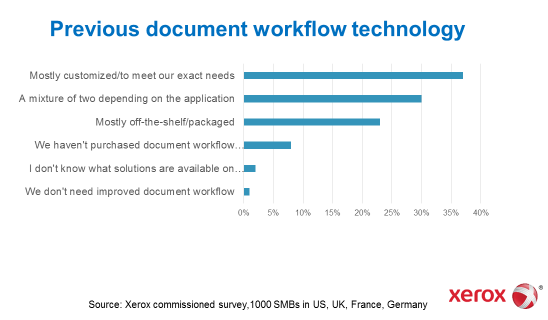The market for managed print and document services (MPDS) is evolving rapidly. As a result, it has become increasingly important for service providers to gain a firm grasp on the issues that impact a successful customer implementation. The following checklist could be used as a guide toward building a successful and profitable MPDS practice.
1. MPDS is Transitioning from a Cost-Based Service to a Value-Add Service
Businesses continue to migrate toward contractual print services to gain control of their document infrastructure and reduce printing costs. Today, however, MPDS involves much more than simply managing and servicing output devices. The real value proposition of MPDS comes from reducing device redundancy, driving operational efficiencies, and improving worker productivity. Leading with these elements allows service providers to expand the value of the print services contract into area such as document management, workflow services, or other IT-related services.
Selling solely on cost provides only short-term value to the customer. With a baseline for cost reduction established, the service provider is vulnerable to competitors that could undercut your position. Building additional value into the contract is key to the successful transformation to a services-led business model. As a value-based service provider, you partner with your customer to understand pain points and become integrated into those business processes that are critical to their success. The key to building a value-based MPDS practice lies in developing strong expertise in digital workflow and other information management services.
2. Why SMB is a Growth Opportunity for MPDS
The market for contractual print services is growing among small- to medium-size businesses (SMBs). In its recently published report titled IDC FutureScape: Worldwide Imaging, Printing, and Document Solutions 2017 Predictions, IDC predicts that more than 25% of midsize organizations will contract with an outsourced print and document services provider by 2018.
The single biggest factor influencing continued adoption in SMB is the inherent dependence on paper-intensive business processes. For many smaller businesses, paper is deeply entrenched in various manual processes that often bridge the gap between lines of business and incompatible business systems. Significant opportunities exist for those service providers with the technology and solutions expertise to help SMBs achieve more advanced stages of print and document maturity.
Advancements in technology and service deliver are also key factors in pushing MPDS adoption down market. Hard copy vendors are now focused on extending cloud services offerings to drive channel partner engagement and simplify the deployment of managed print and document services for SMBs. The rapid development of multitenant, cloud-based print management solutions will further enable adoption. This rationalization of cloud infrastructure combined with subscription-based service delivery models among midmarket service providers and their equipment suppliers will dramatically reduce the costs of deployment, ease the implementation process, and allow smaller businesses to achieve faster return on investment.
3. What are the Barriers to MPS Adoption?
The single biggest barrier to MPDS adoption in the SMB space is tied to the customer’s lack of perceived value for the service provided. For organizations with fewer than 500 employees, reducing printing costs may not necessarily resonate, simply because printing might actually represent a fairly small percentage of the overall IT budget. While a 20 to 30 percent reduction in print costs might seem compelling, it could actually provide minimal impact to the bottom line.
At the same time, poorly implemented print policies that restrict user behavior can cause significant disruption in existing process and workflow, leading to concerns about inefficiencies and lower worker productivity. Smaller businesses have limited IT resources and yet are dealing with most of the same document-related issues facing everyone these days: the transition from paper to digital, inefficiencies tied to legacy paper-based business processes, mobile integration, system integration, and the relentless demand for access to information—when and where it is needed. What SMBs value most are solutions that can help them increase productivity, proactively manage devices, automate workflows, reduce the burden on IT staff, consolidate vendors, and drive better business outcomes.
4. How to Improve Customer Retention Rates
Customer retention rate is one of the most important metrics for measuring the success of an MPDS practice. Once again, the key to maximizing customer retention lies in understanding the customer’s perception of service value. It is important to note that customer perception is likely to change over time, and what was considered important during the initial contract stages may not hold as much value post implementation.
Data from IDC’s MPS Service Excellence Survey, November 2015, demonstrates this point quite clearly. Existing MPDS customers were asked to identify the most influential factors in selecting their service provider at the start of the initial contract, and then asked how those variables would change with the knowledge gained after implementation.
| At the Start of the Contract | With Hindsight |
| 1. Price of the contract | 1. Clearly defined SLA |
| 2. Ability to meet our sustainability objectives | 2. Information and document security procedures |
| 3. Service delivery infrastructure | 3. Price of the contract |
| 4. Information and document security procedures | 4. Breadth of print and document services portfolio |
| 5. Ability to manage our centralized, staffed print/copy center | 5. Tools to enable employee collaboration |
While most customers focus on contract price during the initial stages of negotiation, the perceived value of MPDS shifts over time to variables related more to meeting clearly defined service objectives and providing value-add capabilities. These are the value-add areas that service providers should focus on in order to improve customer retention rates.
5. Why Customers Switch MPDS Providers
Among the many success stories are numerous examples of MPDS engagements that failed to meet customer expectations. As the data above suggests, the single biggest reason that customers switch service providers is a lack of clearly defined SLAs. Poorly structured MPS contracts, tying implementation to improper data metrics, lack of due diligence during the planning phase, and failure to properly consider strategic corporate goals at the onset of the program are all symptoms common to failed MPS deals.
6. Why Security Matters
Organizations face numerous challenges when it comes to securing their IT infrastructure and protecting business-critical assets, and most fail to recognize the security vulnerabilities associated with their print and document environment. While many businesses have contracted with an MPDS provider to optimize their print infrastructure to drive efficiencies and reduce costs, areas related to print and content security have gone largely overlooked.
According to research conducted to inform IDC’s MaturityScape Benchmark: Print Security in the United States, 2016, print security is critical part of a company’s acquisition process for printers and MFPs. More than 70% of respondents said that print security has a high level of influence on the printers and MFPs that they buy or lease. Nevertheless, print security initiatives lag overall IT security initiatives. Respondents indicating that print security was “very important” was 26% less than respondents indicating the IT security was “very important.”
7. How the MPS Channel is Evolving
As the market for print and document services has matured it continues to attract a wide variety of players and service providers. Every equipment manufacturer is offering direct MPDS and programs to enable their channel partners. Many traditional office equipment dealers and resellers have adopted MPDS programs—even retail stores and computer dealers. Meanwhile, channel providers that previously had little desire to sell printers or MFPs, such as managed IT service providers (MSPs), are now getting into the game to expand their services portfolio and drive incremental revenue.

While the competitive landscape continues to broaden, there is no specific channel that is inherently better at delivering and supporting contractual print services. What makes a strong MPDS provider has less to do with legacy business and more to do with a commitment to the MPDS business model, a focus on value-add services, and building out the right set of solutions to meet specific customer needs.
8. How to Structure an Effective Change Management Program
An effective change management strategy is key to a successful MPDS implementation. Businesses need to ensure that employees are fully invested in the program—to raise awareness of the benefits and to actually garner support for the desired changes in document infrastructure and policy.
Most employees will resist change, especially when it is perceived as a direct threat to personal productivity. At the same time, employees have an inherent desire to feel wanted, to know that their employer cares about them and is concerned about their personal and individual needs. The key to an effective change management programs is to ensure that employees are involved in the MPDS process from the beginning, to ensure that individual users are in support of the program goals and that they understand their own role in the program objectives.
It is important to remember that corporate goals and company benefits do not always translate directly to employee benefits. It may be necessary to look beyond issues such as cost savings to generate interest at the employee level. Build a change management strategy focusing on attributes that resonate more effectively with individual employees, such as ways that MPS could have a positive impact on personal productivity. Demonstrate how MPS could help employees do their jobs more effectively and free up time for other tasks. Another important attribute is to look closely at the environmental benefits of the MPDS program, such as reducing waste, driving down paper consumption, and promoting new recycling policies.
9. The Role of MPDS in the Office of the Future
As already mentioned, MPDS is growing in overall scope, complexity, and value—driven in part by new enabling technologies and service delivery models. At the heart of this transition is the smart MFP. Today’s MFPs have become intelligent business processing hubs that serve as an on- and off-ramp to the Internet. The process of managing, storing, sharing, and collaborating with digital information becomes more difficult with the advent of cloud services and mobile computing. In the office of the future, MPDS providers will be able to apply business intelligence through data captured at the MFP to drive greater strategic business value.
Data analytics will offer near-term benefits in areas such as predictive and preemptive service capabilities, creating more efficient and cost-effective service delivery. But in the long run, MPDS providers will have real-time access to data analytics to improve the way businesses work with information, which is not a bad place to be.
10. The Four Pillars of an Effective MPDS Strategy
Based on the issues outlined in this document, the most effective MPDS strategies will be built around five core pillars:
- A Holistic Assessment: Seek to go beyond device distribution, utilization rates, and print volumes to acquire a better understanding of how devices are used, and how information moves through the organization. Assessments that provide the most strategic value are those that evaluate the entire office document environment and not just the allocation of print resources. Using a holistic assessment approach, providers can more easily uncover document-based processes that might be ripe for optimization and automation.
- Print Services: Develop a print services practice that focuses on helping customers understand the role of print in the organization. Leverage state-of-the-art print management tools so that output requirements can be tied directly to process-driven benchmarks.
- Workflow Services: Build out specific workflow services capabilities in areas such as paper-to-digital conversion, document storage and retrieval, information collaboration, and workflow automation. In many cases, customer interest in these capabilities may be more impactful and top-of-mind than simply managing print devices.
- Strong IT Services Capabilities: Service providers with strong IT services capabilities have a distinct advantage in today’s MPDS market. This does not mean that providers need to offer IT services, but it is important to demonstrate expertise in this area to enable consistency in the integration of IT, workflow, security, and print.
- Change Management: Cultivate a change management strategy that involves employees early, focuses on motivators that resonate, and leverages data to drive policy and procedures.
Robert Palmer is Research Director with IDC’s Imaging, Printing, and Document Solutions team. He is responsible for written research, forecasts, and analysis in multiple practice areas covering managed print services, document solutions, business workflow automation and optimization, and hard copy transformation.
Contact your Xerox account manager, or review the Xerox Global Partner Program and apply to become a Xerox channel partner today, to find out how we will help grow your business.
Join our Xerox Channel Partners LinkedIn community
Looking for more marketing tips and insights from Xerox Agents, Concessionaires, and Document Technology partners from across the globe? Join our private Xerox Channel Partners LinkedIn Group to connect and discuss topics like these with your peers.
Become a Xerox Channel Partner
Register to access the Partner Portal and find out more about joining the Xerox Global Partner Program.
Subscribe to the Channel Partner Connection and receive email updates when we publish a new article.[wysija_form id=”1″]



